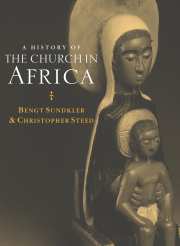Book contents
- Frontmatter
- Contents
- List of maps
- Acknowledgements
- List of abbreviations
- Introduction
- PART I THE FIRST FOURTEEN HUNDRED YEARS
- PART II THE MIDDLE AGES 1415 – 1787
- PART III THE LONG NINETEENTH CENTURY 1787 – 1919
- 3 Overview To The Nineteenth Century
- 4 North and North-Eastern Africa
- 5 Western Africa
- 6 West-Central Africa
- 7 Southern Africa
- 8 South-Central Africa and the Indian Ocean
- 9 East Africa
- 10 East-Central Africa
- PART IV THE COLONIAL EXPERIENCE 1920 – 1959
- PART V INDEPENDENT AFRICA 1960 – 92
- Notes
- Bibliography
- Name index
- Subject index
7 - Southern Africa
from PART III - THE LONG NINETEENTH CENTURY 1787 – 1919
Published online by Cambridge University Press: 16 September 2009
- Frontmatter
- Contents
- List of maps
- Acknowledgements
- List of abbreviations
- Introduction
- PART I THE FIRST FOURTEEN HUNDRED YEARS
- PART II THE MIDDLE AGES 1415 – 1787
- PART III THE LONG NINETEENTH CENTURY 1787 – 1919
- 3 Overview To The Nineteenth Century
- 4 North and North-Eastern Africa
- 5 Western Africa
- 6 West-Central Africa
- 7 Southern Africa
- 8 South-Central Africa and the Indian Ocean
- 9 East Africa
- 10 East-Central Africa
- PART IV THE COLONIAL EXPERIENCE 1920 – 1959
- PART V INDEPENDENT AFRICA 1960 – 92
- Notes
- Bibliography
- Name index
- Subject index
Summary
INTRODUCTION
The theme of the ‘frontiers’ pervades nineteenth-century southern Africa, including the history of the Church, providing its peculiar dynamic and drama. In the nineteenth century in the United States the frontier was a movement westwards, across the continent. In southern Africa there was a corresponding movement northwards, from the Cape over the high veld, beyond the great rivers, to the ‘interior of Africa’. The ‘Great Trek’ from the Cape towards the north is the classical illustration of this move: that exodus of sturdy Boers, supposedly a ‘Chosen People’, struggling along from the rich wheat, wine and cattle farms in the south, over the veld and the mountains, beyond the Orange, the Vaal and the Drakensberg. A second movement north was less far-reaching but no less dramatic and demanding for the individuals and groups concerned. It consisted of the ‘Coloured’ population, sporadically withdrawing from the Cape towards the Orange and Vaal rivers. It resulted in the formation of a Christian Griqua republic which provided a key to the process and patterns of Christianization of some of the leading Bantu-speaking peoples.
Even more dramatic and far-reaching was the cataclysmic refugee movement, beginning in Natal and speeding along with irresistible force annihilating everything in its way, affecting everybody, hurrying over the subcontinent until at long last it spent its force just short of Lake Victoria.
- Type
- Chapter
- Information
- A History of the Church in Africa , pp. 323 - 444Publisher: Cambridge University PressPrint publication year: 2000



